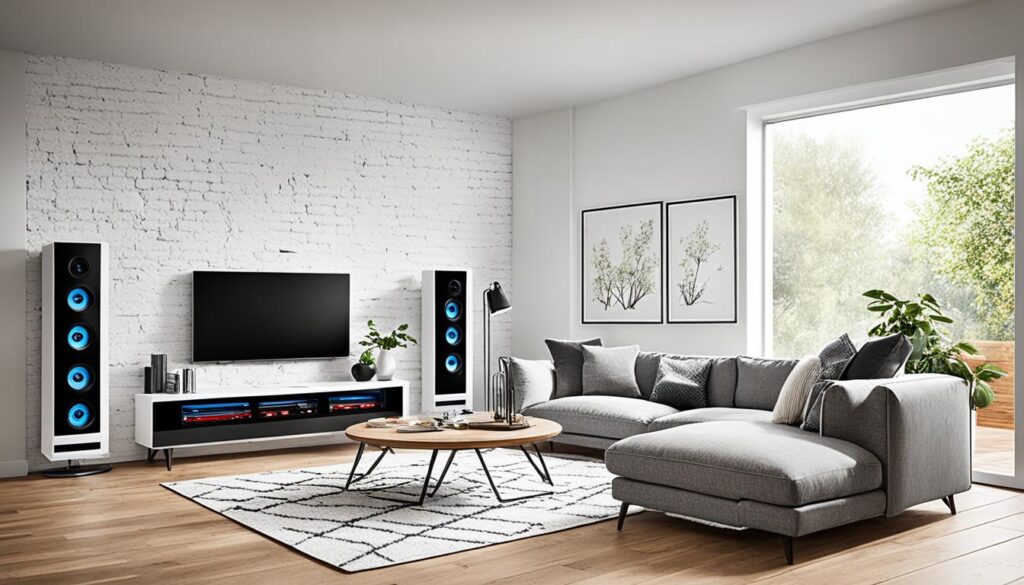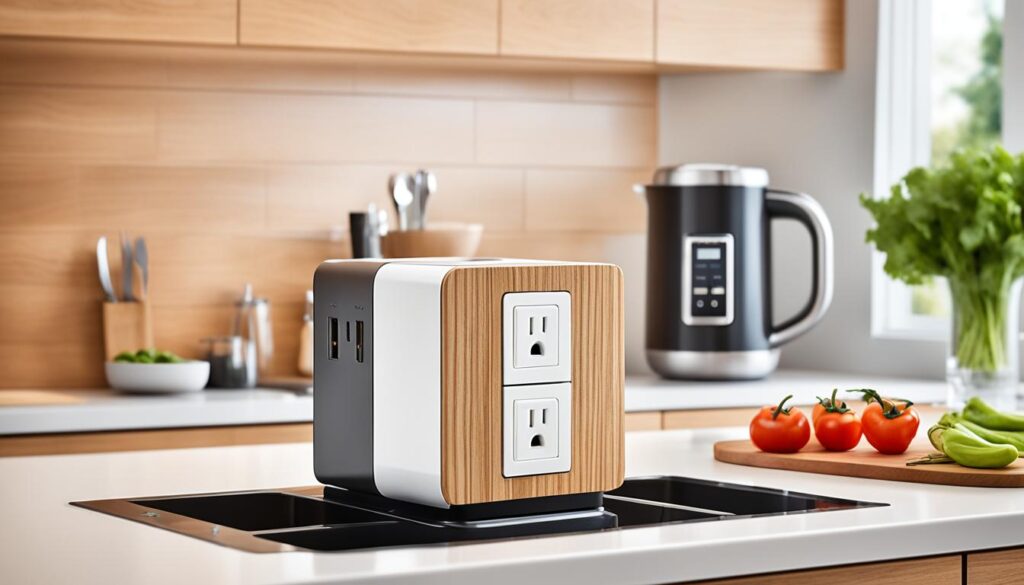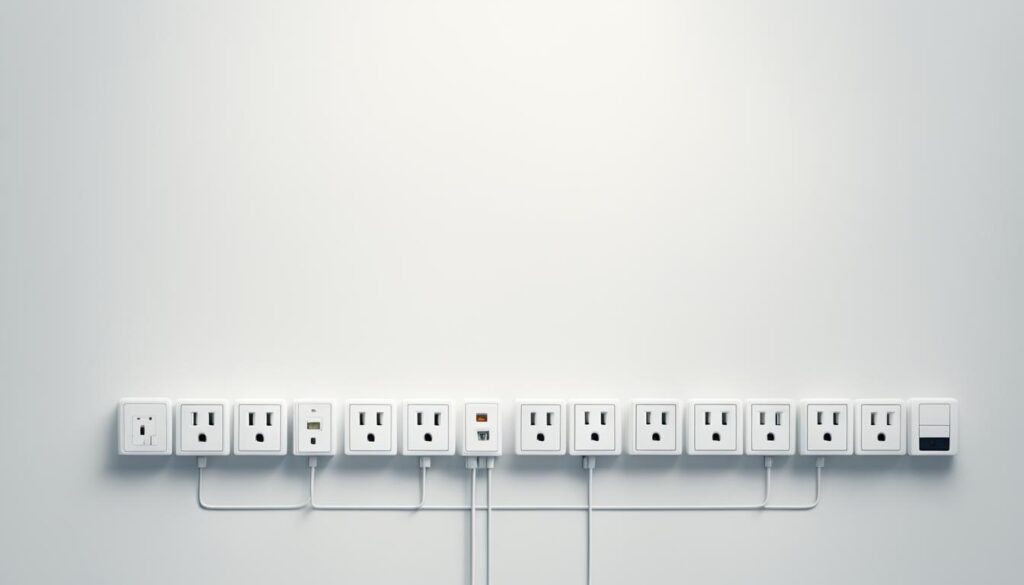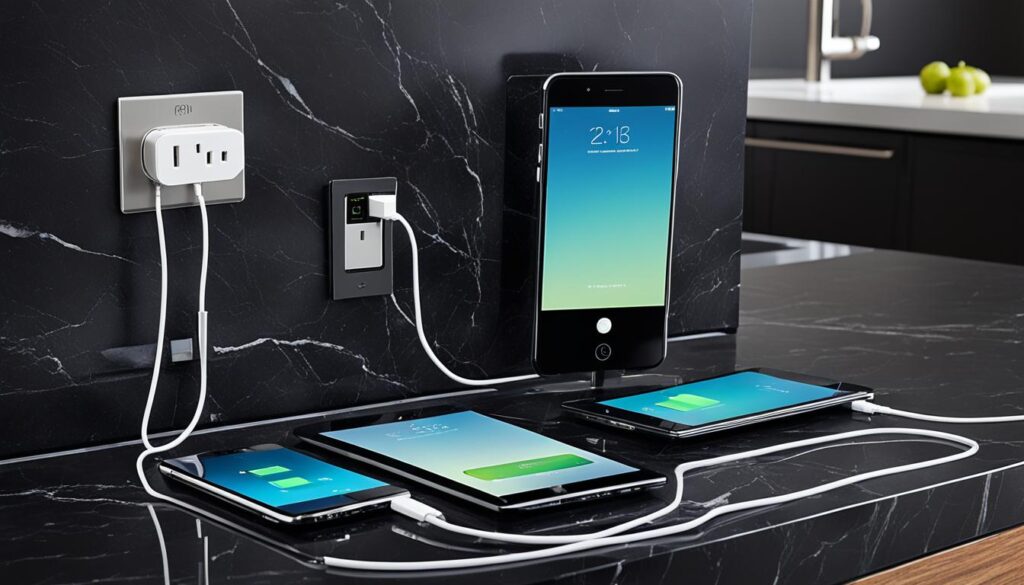Installing electrical sockets requires careful consideration, and there are several factors to keep in mind. These include the number of sockets needed in a room, the desired color or finish of the sockets, the appropriate height for installation, and the compatibility with smart devices. It is also important to be aware of the potential dangers of overloading plug sockets and the importance of surge protectors. In this comprehensive guide, we will explore all of these aspects and more to help you make an informed decision when choosing and installing pop up power outlets in your UK home or office.
Key Takeaways:
- Consider the number of sockets needed in a room based on its purpose and size, ensuring you have enough to avoid the use of extension leads.
- Choose a color and finish for your pop up power outlets that complements your room’s decor, whether it’s contemporary or traditional.
- Install power sockets at the appropriate height according to building regulations, adjusting for existing homes or new build houses.
- Opt for smart-compatible sockets to automate your devices and future-proof your home.
- Avoid overloading plug sockets and use surge protectors to protect against voltage spikes and potential fire hazards.
How Many Wall Sockets Should Be in a Room?
When it comes to installing wall sockets, determining the right number for each room depends on a few key factors. These include the room’s purpose, size, and the number of devices that will require power. To help you with the decision-making process, here’s a general guideline for the number of wall sockets you should consider for different rooms in your UK home or office:
Living Room:
A living room typically requires **4-8** wall sockets. Consider the various entertainment devices you may have, such as the TV, gaming consoles, sound systems, and charging stations for your electronic devices.
Single Bedroom:
For a single bedroom, **2-4** wall sockets are usually sufficient. These outlets can be used to power essentials like lamps, alarm clocks, and chargers for your electronic devices.
Double Bedroom:
In a double bedroom, it is recommended to have **3-5** wall sockets. This allows for more devices like bedside lamps, additional charging stations, and any other electrical appliances you may have in your bedroom.
Kitchen:
The kitchen, being a hub of various electrical appliances, typically requires a higher number of wall sockets. It is advised to have **6-10** sockets to accommodate appliances like refrigerators, microwaves, toasters, blenders, and other kitchen gadgets.
While these are general guidelines, it’s always a good idea to have more sockets than you think you’ll need to avoid the use of extension leads. Having an adequate number of wall sockets ensures convenience and eliminates the need for trailing cables or power strips that can clutter your living space. Remember to consider your specific requirements and the electrical devices you plan to use in each room to make an informed decision.
To help you visualize the number of sockets recommended for each room, refer to the table below:
| Room | Number of Wall Sockets |
|---|---|
| Living Room | 4-8 |
| Single Bedroom | 2-4 |
| Double Bedroom | 3-5 |
| Kitchen | 6-10 |
By following these recommendations, you can ensure that you have enough wall sockets in each room to meet your power needs without compromising on convenience and safety.

Considering Color and Finish
When choosing pop up power outlets, it’s important to consider the color and finish that will best suit your room’s decor. While white plastic sockets are a common choice, there are other options available. For contemporary decor, brushed or polished chrome or sleek slate grey finishes can be perfect. If your room has a more traditional style, you may opt for antique brass or wood effects. It’s also possible to choose different colors and finishes for different rooms to match their individual aesthetics.
Adding a touch of style to your power outlets can enhance the overall look and feel of your space. Whether you prefer a modern, minimalist look or a more classic and rustic ambiance, the color and finish of your pop up power outlets can play a significant role in achieving the desired aesthetic.
If you have a contemporary interior design, brushed or polished chrome finishes can provide a sleek and sophisticated look. These finishes offer a clean and reflective surface, blending seamlessly with modern decor. For a more subdued and elegant appearance, slate grey finish can be an excellent choice. Its smooth and charcoal-like texture adds a touch of sophistication to any room.
On the other hand, if your room has a more traditional or vintage vibe, antique brass finish can help create the desired ambiance. Antique brass outlets give a warm and rustic feel, reminiscent of old-world charm. Additionally, wood effects are a popular option for those seeking a natural and organic look. These finishes mimic the appearance of wood, allowing you to integrate power outlets seamlessly into wooden surfaces without compromising on style.
“The right color and finish can transform a power outlet from a functional necessity to an attractive design element.” – interior design expert, Jane Mason
Remember, it’s not just about choosing a color and finish that matches your room’s decor; it’s also about achieving a cohesive and harmonious overall look. If you have multiple rooms with different themes or color palettes, you can explore the option of selecting various colors and finishes for each room. This way, you can maintain the consistency of your room’s design while ensuring that every power outlet complements its surroundings.

For example, in a modern and minimalist living room with brushed chrome accents, you can choose pop up power outlets with a brushed chrome finish to seamlessly blend into the design. In a cozy and traditional bedroom with antique furnishings, antique brass finish power outlets can add a touch of elegance and continuity.
By considering the color and finish of your pop up power outlets, you can elevate your space by seamlessly integrating functionality with style. Whether you prefer a contemporary or traditional look, there is a wide range of options available to suit your aesthetic preferences.
Installing Power Sockets at the Right Height
When it comes to installing power sockets, it’s crucial to consider the appropriate height based on building regulations and the specific room where the sockets will be placed. Whether you’re adding sockets to an existing home or a new build house, adhering to these guidelines ensures compliance with safety regulations and promotes optimal functionality.
In existing homes, the ideal approach is to align the new power sockets with the height of the existing ones. This maintains consistency and makes it easier for users to access the sockets without bending down or stretching too far. By placing the sockets at the same height, you maintain a uniform appearance throughout the space.
However, in the case of new build houses, building regulations specify specific requirements for socket height. According to these regulations, power sockets should be positioned at least 450mm up from the floor. This height allows for ease of use and reduces the risk of accidental contact with electrical currents.
In addition, building regulations state that power sockets should be positioned at least 350mm away from the corners of the rooms. This spacing ensures that the sockets are easily reachable and minimizes the risk of obstructions from furniture or other objects.
When it comes to installing power sockets in kitchens, extra precautions must be taken due to the presence of water sources and potential hazards. In this area, the recommended height for power sockets is at least 100mm above the worktop. Placing the sockets at this height prevents water or other liquids from coming into direct contact with the electrical outlets, reducing the risk of electrical shock.
By following these guidelines and considering the specific requirements for different areas of your home or office, you can ensure the safe and efficient installation of power sockets.

Smart Compatibility
If you have other smart devices installed in your home, such as smart lights, security systems, or speakers, it is worth considering smart sockets that can be connected to these devices for automation. For example, a smart socket can turn on a radio if it detects movement from a smart motion detector while you’re away, potentially deterring burglars. Even if you don’t have any smart devices currently installed, it’s a good idea to choose sockets that are compatible with future smart devices you may want to add to your home.
Enhancing Automation with Smart Devices
Smart compatibility allows you to create a seamlessly connected home ecosystem that is responsive to your needs. By integrating smart sockets with your existing smart devices, you can automate various tasks and enhance your home’s efficiency and security.
“Connecting your smart sockets to other devices gives you complete control and customization options. You can set schedules, create smart home routines, and even control your sockets remotely using your smartphone or voice assistants like Amazon Alexa or Google Assistant.”
In addition to convenience, smart sockets can also contribute to the safety and security of your home. For instance, you can program your smart sockets to turn on lights or activate appliances at specific times, creating the illusion of occupancy when you’re away. This can help deter potential intruders and give you peace of mind.
Future-Proofing Your Home
Investing in smart sockets that offer compatibility with a wide range of devices ensures that your home is ready for future advancements in technology. As the smart device market continues to expand, you may find yourself wanting to add new devices to your home automation system.
By choosing smart sockets with smart compatibility, you can effortlessly incorporate new devices into your existing setup without the need for additional adapters or rewiring. This not only saves you time and money but also ensures a seamless and integrated user experience in your smart home.
Safeguarding Your Smart Home Ecosystem
When selecting smart sockets, it is essential to consider their compatibility not only with home automation systems but also with the protocols commonly used by smart devices. The most popular protocols include Wi-Fi, Zigbee, and Z-Wave.
By opting for smart sockets that support multiple protocols, you can accommodate a wider range of smart devices, ensuring a robust and versatile smart home ecosystem.

| Protocol | Advantages | Devices |
|---|---|---|
| Wi-Fi | Wide compatibility / Easy setup | Smart speakers, lights, cameras, thermostats |
| Zigbee | Mesh network / Low power consumption | Smart bulbs, sensors, locks |
| Z-Wave | Mesh network / Robust security | Smart locks, switches, thermostats |
The Dangers of Overloading Plug Sockets
Overloading plug sockets with multiple electrical appliances can be a fire hazard and pose a significant risk to your safety. When too many devices are plugged into a single socket, it can lead to power overload and potentially cause the plug to overheat. This overheating can result in damaged wires, melted insulation, and even ignite a fire.
One of the main contributors to overloading plug sockets is energy-guzzling appliances. These appliances, such as air conditioners, electric heaters, and high-wattage kitchen appliances, consume a significant amount of power. When these energy-guzzlers are grouped together and plugged into the same socket, they put a tremendous strain on the electrical circuit and increase the risk of overheating.
It’s crucial to be aware of the power consumption of your appliances. Each electrical device has a wattage rating, which indicates the amount of power it consumes. To prevent overloading, check the wattage rating of your devices and ensure that the total wattage of the appliances plugged into a single socket does not exceed a safe limit. The recommended safe wattage for a typical UK domestic plug socket is around 3,000 watts.
To reduce the risk of overloading plug sockets, it’s advisable to distribute your appliances across multiple sockets instead of concentrating them in one area. Avoid daisy-chaining extension leads or using too many multi-plug adapters, as these can exacerbate the problem by adding more devices to an already overloaded circuit.
“Overloading plug sockets is not only a fire hazard but also a common cause of electrical accidents. It’s essential to distribute your appliances wisely and follow the recommended wattage limits to ensure your safety.”
– Electrical Safety Expert
Using surge protectors is another effective way to enhance safety and protect against overloading. Surge protectors are designed to absorb excess voltage and prevent it from reaching your electrical devices. They can help safeguard your appliances from power surges caused by internal issues or external factors like lightning strikes. Remember, surge protectors should be periodically replaced as they have a limited lifespan, typically every two years.
By being mindful of your power consumption, adhering to safe wattage limits, and utilizing surge protectors, you can significantly reduce the risk of overloading plug sockets and ensure the safety of your home or office.
Takeaway Tips:
- Be aware of the power consumption of your appliances and ensure that the total wattage does not exceed the safe limit.
- Distribute your appliances across multiple sockets to avoid overloading a single socket.
- Avoid daisy-chaining extension leads and using excessive multi-plug adapters.
- Consider using surge protectors to protect your devices from power surges.
- Periodically replace surge protectors to maintain their effectiveness.
Surge Protectors and Their Importance
Surge protectors play a crucial role in safeguarding our electrical devices from the damaging effects of voltage spikes caused by internal tripping events and lightning strikes. By limiting the amount of voltage supplied to our devices, surge protectors help prevent irreparable damage to sensitive electronic equipment.
With the increasing reliance on electrical devices in our daily lives, it is essential to have reliable surge protectors in place to ensure their longevity and optimal performance. Voltage spikes can occur unexpectedly, leading to sudden power surges that can fry circuitry and render our devices useless.
It is worth noting that surge protectors have a limited lifespan and should be replaced periodically to maintain their effectiveness. Experts recommend replacing surge protectors at least every two years to guarantee their ability to protect against voltage fluctuations.
While some surge protectors feature built-in indicator lights that signal when a replacement is needed, it is not advisable to solely rely on this feature. It is best to be proactive and follow the recommended replacement frequency to ensure continuous protection for our valuable electrical devices.
The Benefits of Surge Protectors
Investing in surge protectors provides numerous benefits, including:
- Protection from voltage spikes due to internal tripping events and lightning strikes
- Preservation of sensitive electronic equipment
- Increased lifespan of electrical devices
- Enhanced safety by reducing the risk of electrical fires
By incorporating surge protectors into our electrical setups, we can enjoy peace of mind knowing that our devices are shielded from unexpected power surges that could otherwise lead to expensive repairs or replacements.
“Surge protectors are like insurance for your electrical devices. They offer necessary protection against voltage irregularities, ensuring the longevity and optimal performance of your valuable electronics.”
– Electrical Safety Expert
To demonstrate the importance of surge protectors, consider the following table:
| Scenario | Without Surge Protector | With Surge Protector |
|---|---|---|
| Internal Tripping Event | Device suffers irreparable damage | Surge protector diverts excess voltage, preserving device |
| Lightning Strike | Device rendered inoperable | Surge protector absorbs and dissipates lightning-induced surge |
| No Surge Protector Replacement | Device remains vulnerable to power surges | Surge protector continuously ensures device protection |
Conclusion
In conclusion, the pop up power outlet guide provides a comprehensive overview of the benefits, safety, and convenience that these outlets offer for UK homes and offices. By considering various factors such as the number of sockets needed, color and finish options, installation height, smart compatibility, and the dangers of overloading and the importance of surge protectors, individuals can confidently select and install pop up power outlets that meet their specific requirements.
Pop up power outlets not only provide easy access to power but also minimize clutter and enhance the aesthetics of any space. Whether it’s for the living room, bedroom, kitchen, or office, these modern and efficient outlets offer a sleek and practical solution to satisfy a wide range of power needs.
With their ability to seamlessly blend into any decor, pop up power outlets offer the perfect balance between functionality and style. Safety features, such as surge protectors, protect electrical devices from voltage spikes, ensuring the longevity of valuable equipment. By investing in pop up power outlets, individuals can create a more organized and visually appealing environment while enjoying the convenience and peace of mind that comes with a well-designed electrical system.

